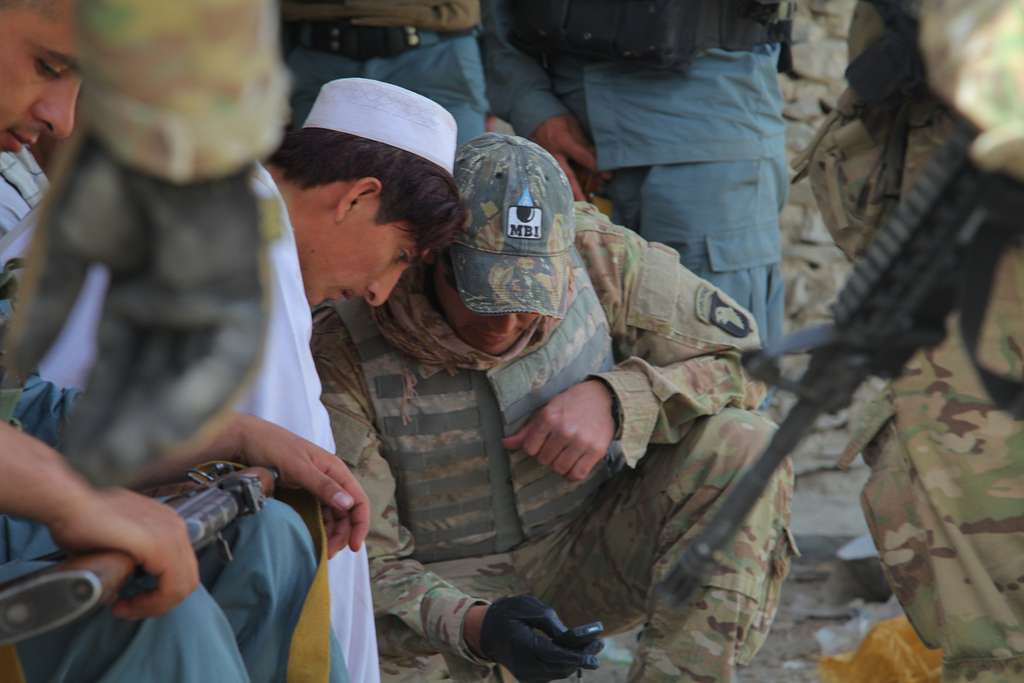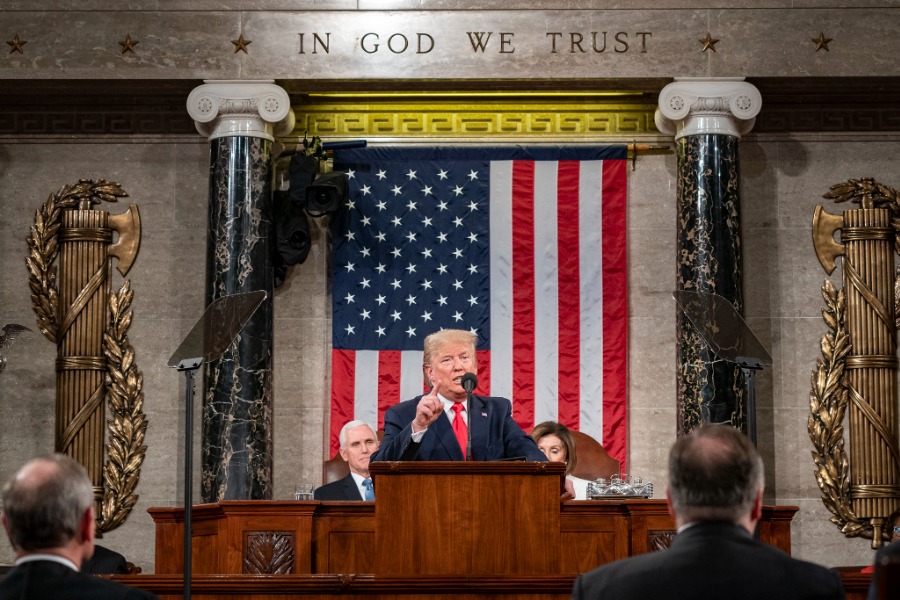How Congress Should Respond to the White House’s Failures on Syria Transparency
Last week, one of us co-authored a summary of a new report on the legal and policy frameworks for the use of force and other national security operations required by Section 1264 of the National Defense Authorization Act (NDAA) for fiscal year 2018
Published by The Lawfare Institute
in Cooperation With

Last week, one of us co-authored a summary of a new report on the legal and policy frameworks for the use of force and other national security operations required by Section 1264 of the National Defense Authorization Act (NDAA) for fiscal year 2018. While the report was delivered on time, it was not made widely available and, disappointingly, provided a mere eight pages of information with few details, a departure from the December 2016 Obama administration report on which it is based. It was also largely repetitive of what we already knew, restating word-for-word prior Trump administration statements.
Nor was this the only Syria-related report required by the NDAA. Section 1221 of the NDAA required a separate report on the U.S. strategy in Syria, including legal authorities, which was due to Congress on Feb. 1. As far as anyone can tell, the administration has not reported anything to Congress, either classified or unclassified, meaning the second report is overdue and missing.
The administration has taken a serious step backwards on transparency on these important issues, despite the legal mandates set forth in the NDAA. These reports could provide much needed transparency on the administration’s view of its legal authority to use military force around the globe, and have implications beyond Syria (North Korea included). With the administration failing to take seriously these statutory reporting requirements, now is the time for Congress to elevate its oversight so that Congress and the American public can exercise their constitutional role on war powers. In our democracy, it is unacceptable for the administration to keep Congress and the public in the dark about its legal justification for using protracted military force around the globe.
Escalation in U.S. Presence and Use of Force
Before getting to the legal rationale, recall the relevant background on what is happening in Syria.
U.S. military action in Syria has escalated significantly since the last administration. Previously, in Syria, the U.S. use of force was limited to the Islamic State and groups associated with al-Qaeda, which the prior administration justified under the 2001 and 2002 authorizations for use of military force (AUMFs), as does the current administration. Since the Trump administration entered office, however, military operations have expanded to include the use of force against certain Syrian government and pro-regime forces. In April 2017, the Trump administration launched missile strikes against the Syrian government by attacking the Shayrat airbase in retaliation for its despicable chemical weapons attacks, actions which Defense Secretary James Mattis threatened to repeat in February, were reportedly considered again in March, and that U.N. Ambassador Nikki Haley threatened earlier this month.
In addition to the April 2017 attack, the U.S. struck Syrian government and pro-regime forces in May and June of 2017, and more recently, in February 2018, justifying these actions as defensive actions against threats to or attacks on U.S. and partner forces. The most recent action resulted in the deaths of Russian mercenaries, who were in Syria with regime forces.
Further, in January 2018, Secretary of State Rex Tillerson announced an indefinite U.S. military presence in Syria to remain even after ISIS is largely defeated. Through public statements and a pair of letters to Sen. Tim Kaine (D.-Va.), the Defense Department and State Department have indicated that this presence is intended to prevent a resurgence of the Islamic State and therefore justified under the 2001 and 2002 AUMFs, among other authorities. Notably, in recent letters to Sen. Tim Kaine, neither the State Department nor the Defense Department contemplate new authorization from Congress for an extended presence.
Legal Rationale: What is Missing in Current Justifications
Despite significantly escalating the use of force in Syria, this administration hasn’t provided an adequate explanation of its legal authority.
For the April 2017 strikes, the administration’s sole justification is an unprecedented expansion of the president’s constitutional war-making authority. In discussing this incident, the use of force report says that: “Article II of the Constitution provides authority for the use of military forces in certain circumstances even without specific prior authorization of Congress” and offers the April 2017 strike as an example where the President executed this authority in pursuit of “vital national security and foreign policy interests.” This interpretation of Article II could, as Sen. Kaine stated in a December 2017 hearing, “completely wipe out Congress’s power [to declare war] under Article I” if not set within some limits. Further, it simply repeats nearly verbatim the president’s April 8 notification to Congress regarding the strikes, which Secretary Tillerson later summarized in a mere few sentences. Nothing in the use of force report offers additional explanation on the Trump administration’s views regarding the scope of the president’s Article II war powers. And as with previous statements, the use of force report lacks any justification for the use of force under international law whatsoever.
For the May 2017, June 2017 and February 2018 strikes against the Syrian government and pro-regime forces, the use of force report relies on the 2001 AUMF, which “provides authority to use force to defend U.S., Coalition, and partner forces engaged in the campaign to defeat ISIS to the extent such use of force is a necessary and appropriate measure in support of counter-ISIS operations.” As for international law, the report asserts that “necessary and proportionate use of force in national and collective self-defense against ISIS in Syria includes measures to defend U.S., Coalition, and U.S.-supported partner forces while engaged in the campaign to defeat ISIS.” This thin description fails to provide the needed transparency on where the AUMF authority ends, particularly as this authority is being used to justify engagements with Syrian and, in the case of the February 2018 incident, Russian-backed forces, both of which present a substantial risk of escalation.
Finally, for the continued U.S. military presence in Syria after the defeat of ISIS, the lack of coherence between this report and prior statements shows why the administration must complete its Syria-specific report. Absent clear plans on the mission and length of the U.S. presence, we have no reason to think it will not be as broad and indefinite as Secretary Tillerson initially announced. With that lens, the use of force report’s assertion that these actions are being undertaken “pursuant to the authority provided by statute”—including, presumably, the 2001 and 2002 AUMFs as well as the Syria train and assist authorities in the NDAA it specifically cites—“and the Constitution” are too vague to be the legal justification for an indefinite U.S. presence.
That there’s no sign of the Syria report, and that the use of force report is barebones, is even more frustrating because we know that the administration’s lawyers have written at least some of this analysis, but are refusing to turn it over. In litigation pursued by our nonprofit organization, Protect Democracy, we have sought the legal rationale for the April 2017 Syria strikes through Freedom of Information Act requests. In a Vaughn index of withheld documents, however, the government disclosed the existence of a seven-page legal memo, which it stated is largely unclassified, and will be used for advising the president on “future military actions.” That seven pages of legal analysis is certainly much more than the one paragraph in the use of force report. Thus, there appears to be a substantial gap between what the administration has written about its views of its legal authorities and what it has disclosed to Congress.
A Democratic Norm, Not Just a Reporting Requirement
In a democracy, when the government deploys military force, Congress and the public should—at a minimum—understand what its legal authority for doing so is. As Judge Chris Cooper of the D.C. federal district court has said about the use of force debates, “being closed off from such a debate is itself a harm in an open democracy.”
Compliance with reporting requirements is often seen as a technical matter for the bureaucracy, but this shouldn’t be the case here. The NDAA’s reporting requirements are about the justification behind decisions of war and peace, the most weighty ones our government makes. Those decisions bear on the shared constitutional roles in war-making between Congress and the executive. Scholars and lawyers have long debated how the Constitution distributes the war powers between the president and Congress and when the United States may and should use force under international law. We must have that debate openly so citizens can weigh in and hold their elected officials accountable through the democratic process.
In order to do so, the executive branch has to be transparent about the legal justifications for its actions. It can do so in many ways. Administrations typically explain their reasoning voluntarily, whether through speeches, written statements, congressional testimony, and even fact sheets. More formally, many executive branch written opinions have been made public about military actions where a congressional authorization did not already exist, such as in Libya in 2011, Iraq in 2002, and Haiti in 1994. In general, presidents have gone to Congress for major or prolonged uses of force and laid out their rationale, such as when President Bush sent the military into Afghanistan and Iraq or when President Obama sought congressional approval for strikes in Syria in 2013.
This administration has not only ignored these norms but also ignored statutes mandating such disclosure. And issues of classification are no excuse. While Section 1264 of the NDAA allows for a classified annex to the use of force report, the initial December 2016 use of force report was a robust 66 pages of unclassified material, compared to the eight pages in this year’s report. There is no reason why the explanation of the legal underpinnings for military action, which the 2018 report calls for, should be classified, unlike the sensitive facts of such actions, which can be. For example, in our litigation for the April 2017 Syria legal memo, the Office of the Director of National Intelligence told the court that only “discrete words and phrases” on a single page about the factual background were classified. There is no reason to think the same is not true of other relevant analysis.
Congress Must Respond
The Trump administration has had more than ample opportunity to articulate its legal views on Syria. We know from Protect Democracy’s FOIA litigation that the Trump administration has prepared unclassified materials on this issue. It just wants to keep them secret. This failure to take the NDAA reporting requirements seriously requires Congress to ratchet up its use of its oversight tools and extract answers from a recalcitrant executive.
Here are three ways that Congress can and should exercise its oversight powers.
First, because the administration has failed to produce the Syria report entirely, and also failed to submit a meaningful, comprehensive Use of Force report, Congress should demand very specific answers on the administration’s legal views in different theatres. The upcoming Secretary of State nomination hearing for current CIA director Mike Pompeo gives senators the opportunity to question him on the Administration’s views on when it can use force, and what it believes its constraints to be. Also, senators should ensure that he will commit to providing transparent answers to Congress when it asks in the future.
Second, relevant Committees should consider holding a hearing with each relevant agency’s head legal counsel: Jennifer Newstead, the legal adviser at State; William Castle, the Department of Defense’s acting general counsel; and Steven Engel, assistant attorney general in charge of the Office of Legal Counsel. None of these officials have testified in their current roles before Congress in this administration, as their predecessors did, on the legal basis for the use of force in Syria and elsewhere. As the Trump administration has been recalcitrant in providing information that Congress has statutorily required, it’s time for Congress to bring those lawyers up to the Capitol to draw it out of them with questions, and maybe, finally, get some answers.
Third, Congress has a series of oversight tools and it should use them. Some members have written letters asking for documents and other specific pieces of information from the administration. Now that the administration has fallen short on its statutory reporting obligations, congressional committee majorities should use formal oversight letters—and if necessary subpoenas—to get relevant administration documents.
Congress gave the administration a clear statutory direction to meaningfully report on its legal authority for the use of force generally, and in Syria specifically. The administration has yet to live up to these obligations. It’s now up to Congress to respond in a more muscular way to ensure that it receives satisfactory answers, both to ensure balance between congressional and executive war powers and to facilitate the public debate on these issues that our democracy requires.






